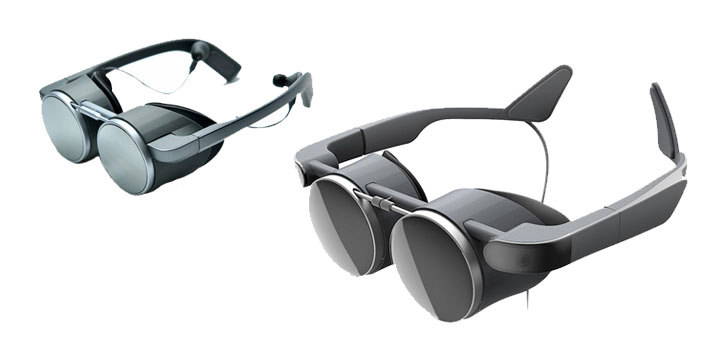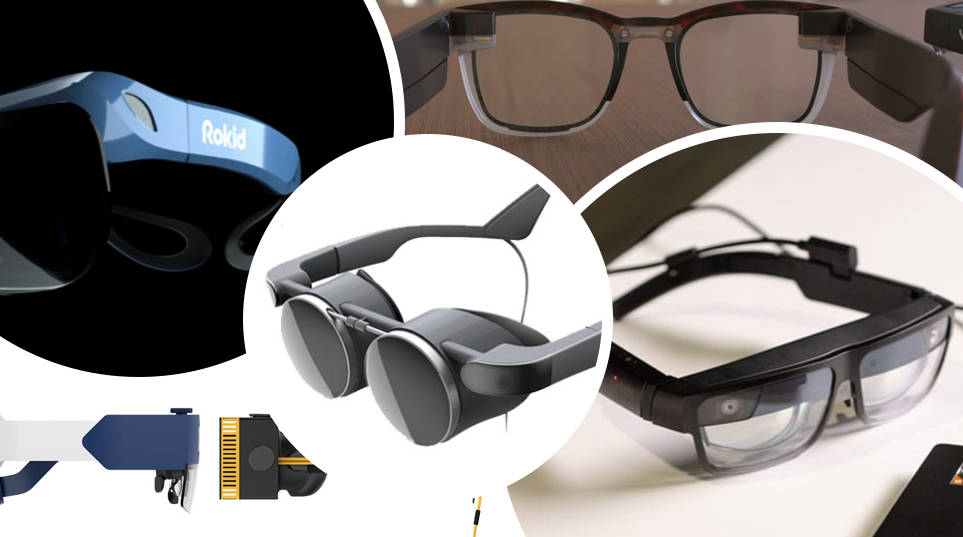Hardware manufacturers for AR and VR devices have traditionally taken advantage of CES to demo their latest tech – and this year’s CES was no exception. At the end of 2020, there were rumors beginning to swirl about Apple developing their own AR and VR glasses, as well as Facebook working on the Oculus Quest 3 – but what emerged at CES turned out to be a lot more interesting – and practical. Here’s a bit of what caught our eye this year.
Vuzix’s Normal-Looking Smart Glasses
Vuzix, an augmented reality and wearable tech developer, unveiled the Next Generation Smart Glasses (NGSG) that will have a “virtually indistinguishable look and feel from normal eyeglasses”. Introduced last year with Vuzix’s M4000 smart glasses, the NGSG will also use dual see-through advanced waveguide optics.
In partnership with Jade Bird Display, the NGSG will be powered by a pair of highly efficient, monochrome and RGB microLED projectors, measuring “as small as the cubic size of a pencil eraser”. Additionally, the smart glasses will feature noise-canceling microphones for phone calls and voice/UI integration, acoustic chambers fully integrated into the frames to deliver clear stereo, and smartphone integration to enhance hands-free operation using voice commands.
“Vuzix smart glasses increase productivity, improve worker safety, lowers carbon footprint, reduce worker errors, protect worker health, and eliminates travel costs,” said Paul Travers, Vuzix’s CEO.
Lenovo’s versatile smart glasses for the enterprise
Focusing on the enterprise, Lenovo’s ThinkReality A3 smart glasses feature an “ultraportable and comfortable” design, creating “a customized, expanded personal workspace anywhere, from a virtual monitor at home, to guided schematics on the factory floor”. With dual 1080p AR displays, an 8MP RGB camera, and a Qualcomm XR-1 chip, Lenovo claims the A3 allows users to “view documents, collaborate with team members, and visualize 3D digital models with crystal clear resolution”.
To enhance productivity for office professionals and industrial workers, Lenovo created two ThinkReality A3 solutions: the PC Edition, and the Industrial Edition. By tethering the A3 to a computer, the PC Edition expands the value of PCs by enabling users to position up to 5 virtual monitors. Through an Android mobile device connection, the Industrial Edition focuses on enabling remote field workers to increase productivity, reduce error rates, and decrease resolution time.
“ThinkReality is more than just technology or a pair of AR glasses,” Mattney Beck, Lenovo’s Commerical AR/VR Marketing Manager, said. “It’s a suite of solutions that includes a scalable software platform, which gives our customers the ability to manage applications and devices through a single interface.”
The World’s First Light-Field AR and VR Headset
Back in 2019, SPAR 3D wrote about CREAL’s light-field technology, which creates more immersive, real, and fluid AR experiences by projecting images with real optical depth, allowing eyes to naturally change focus between virtual objects at different distances, complete with the defocusing effect. During CES 2021, CREAL shared some promising news, showcasing the first two products using light-field technology: an AR and a VR headset.
“That’s only the beginning,” Tomas Sluka, CREAL CEO and Co-Founder, commented. “We have a team of engineers that, in two years, plan to scale down our light-field technology to a smaller form factor, reduce the costs, and improve the rendering efficiency.”
By 2022, CREAL wants to push both headset’s refresh rate up to 270 Hz and improve the FoV from 60 on the AR and 100-degrees on the VR to 60 with foveated rendering and above 100, respectively. The company also wants to create a custom solution to replace Intel RealSense for 6 DoF tracking, Pupil Labs for Eye-tracking, and Leap Motion for hand tracking. Both headsets are now in an evaluation stage, with both AR and VR engines available for integration with other products.
Panasonic World’s First HDR Capable UHD VR Eyeglasses
Unveiled last year at CES 2020, Panasonic claims its new VR glasses are “the world’s first HDR-capable UHD VR eyeglasses, offering ultra-high-quality images and optimal sound that deliver realistic sensations”. This year, the company came back to CES 2021 to showcase a new design and upgraded panel to further challenge conventional VR Head Mount Display (HMD) devices and their bulky and uncomfortable design.
Featuring dual 2,560 × 2,560 micro-OLEDs with a pixel density of 2,245ppi, Panasonic’s compact and lightweight VR glasses now have better weight distribution due to an improvement to the device’s arms and the shape of the fins to better grip the user’s head. The image below shows last year’s model (left side) versus the current one (on the right). Also, with the new arms, Panasonic replaced the integrated earbuds with a new onboard audio system built by Panasonics’ subsidiary Technics which looks like what Oculus has been using in their latest devices.

2019 model (left) vs. 2020 model (right) of Panasonic’s VR glasses.
Revolutionizing the Future of Work Environments With Rokid
Rokid, an MR/AR startup developing enterprise solutions for development communities, unveiled the lightweight, binocular MR glasses, Rokid Vision 2. Designed for cultural tourism, exhibition/museums, medical, industrial, and many other industries, the glasses are 4G and 5G compatible. Folded like an ordinary pair of glasses, Rokid’s MR glasses feature a 40-degree FOV, equivalent to viewing a 120-inch TV that is 4 meters away, and its display uses diffractive optical waveguide technology with a light transmittance of 85%.
Equipped with dual directional speakers and a hands-free voice control interface with dual microphones to accurately detect voice commands in any environment, the Vision 2 combines AR and AI capabilities to easily integrate MR with the real world and improve productivity while providing users with immersive experiences.
“Rokid is not only a company that creates products but also an interactive platform that integrates human, virtual and real worlds,” says Mingming Zhu, Founder and CEO of Rokid.
“XR is the next-generation platform that can perfectly integrate human-computer interaction through voice, vision, and display. It completely changes the ways we work, live, learn, and entertain. Rokid will continue to enable partners through innovative user interfaces and advanced products to reach more industries and consumers, ultimately reaching our mission to ‘Leave Nobody Behind’.”






